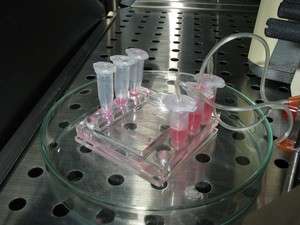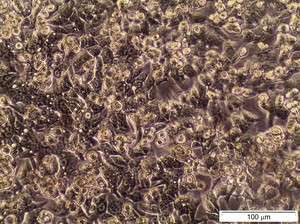Step toward a bioartificial liver device: A microreactor for hepatocyte cultures

Liver cells are very sensitive hence are difficult to cultivate outside the body. However, scientists from the Nałęcz Institute of Biocybernetics and Biomedical Engineering, Polish Academy of Sciences have shown that with an appropriately designed microreactor such cultivation is possible. The presented demonstrator can potentially be used to try to build a bioartificial liver device.
In the modern laboratories, human and animal cells are usually cultured in a standard culture dishes, under the conditions significantly different from those normally found in the living organism. This fact makes the proper development of many types of cells difficult. Na??cz Institute of Biocybernetics and Biomedical Engineering, Polish Academy of Sciences (IBIB PAN) in Warsaw has just presented a novel perfusion microreactor demonstrator for hepatocyte cultures. These liver-derived cells are considered particularly demanding in terms of culture conditions.
"In microreactors, unlike conventional static cell cultures in microplates, there is a possibility of precise controlling cellular environment and providing cells with favorable conditions for growth. However, as hepatocytes have very high requirements, meeting these requirements, even in a microfluidic systems, is not easy", says Prof. Dorota Pijanowska, PhD, Eng., IBIB PAN.
The microfluidic bioreactors built in IBIB PAN are small plates of transparent polymer that fit in the hand. Each bioreactor is formed by bonding two parts, where one of them is equipped with the system of microchannels and cell culture chambers (created using replica molding method). Next, cells are introduced into the bioreactor's culture chambers and the cell culture medium flowing through the system in a continuous manner provides the cells with nutrients and removes metabolites.
Liver cells have a high oxygen demand. Providing them with a sufficient quantity of this element in the entire volume of the culture chamber of the bioreactor may be problematic. "Due to relatively low solubility of oxygen in the cell culture medium, in the metabolically active cell cultures, low flow velocities could result in oxygen concentration gradient in the culture chamber", Dr. Barbara Wawro (IBIB PAN) explains. Close to the medium inlet cells have enough oxygen, while those located farther could remain oxygen deficient.

"The problem of oxygen providing could have been solved by simply increasing the medium flow rate. Unfortunately, a higher flow rate leads to an increase in shear stress to which hepatocytes are very sensitive. That is why we had to look for other solutions", Dr. Wawro went on to explain.
The researchers took advantage of the properties of the polymer from which the microreactor was built, namely polydimethylsiloxane (PDMS) – the one of the highest gas permeability. In the novel bioreactor cells grow on PDMS membrane with a thickness of 150 micrometers. It is strong enough to allow normal operation of the device, but at the same time so thin that oxygen from the environment can penetrate into the growth chamber.
The small height of the chamber – only 100 microns – allows diffusion and uniform distribution of the oxygen throughout the bioreactor chamber. An additional advantage of PDMS is its transparency – therefore microreactor allows continuous microscopic observation of growing cells during culturing.
Currently researchers work on modifications of the bioreactor. A team from the Technical University of Lodz, responsible for covering the surface of PDMS with various diamond-like carbon layers (DLC) of different textures, is participating in the project. This type of surfaces affects the growth of cells and may allow the development of their desired features. In addition, engineers from the University of Science and Technology (AGH) are involved in developing an optoelectronic cells detection sensor.
"There are not too many hepatocytes in a single bioreactor. But our bioreactors are modular and can be combined with each other. In the future, such a complex, after rescaling and other necessary adjustments, could potentially be efficient enough to function as an artificial liver", Prof. Pijanowska has noted.
Construction of microreactor for liver cells culture was one of the goals of just finished MNS-DIAG project (Micro- and Nanosystems in Chemistry and Biomedical Diagnostics), funded by the European Innovative Economy Operational Program. The project was coordinated by the Institute of Electron Technology (ITE) – the developer of silicon masters for hepatocyte bioreactor. The project involved 14 research teams from leading Polish scientific institutions, among which are technical, medical and agricultural universities as well as R&D institutes and the institutes of Polish Academy of Sciences.
Five analysis and diagnostics demonstrators for detection of psychotropic drugs in the human body fluids, for analysis of nano-liters amount of body secretions for the research of pathological states and for determination of stages of fertility, for biological cell cultures (tissue) of controlled characteristics, for the study of selected characteristics of the state of human body using microsystems technology, and for detection of Gram-negative bacteria and the endotoxin secreted by them constituted the goal of cooperation in the implementation of MNS-DIAG project.
Na??cz Institute of Biocybernetics and Biomedical Engineering, Polish Academy of Sciences (IBIB PAN) in Warsaw is the largest research center in the field of biomedical engineering in Poland. The main research areas of the Institute are biomeasurements combined with computer data processing and analysis for the purpose of medical diagnosis and support and replacement of lost body functions by using technical and hybrid tools, including physical and mathematical models of the selected organs and physiological systems and their computer simulation. A Center for Excellence, dealing with artificial and hybrid internal organs supporting metabolism, is operated by the Institute. IBIB PAN is a coordinator of BIOMEN national research network conducting research in the field of biomedical engineering. The results of the research works, in the form of original diagnostic systems and therapeutic methods, have been incorporated into clinical practice in a number of Polish medical centers.
















